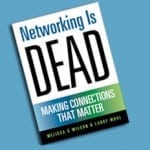 I’ve always been a big proponent of partnerships and strategic alliances. I believe that in most cases, two heads are, in fact, better than one. Luckily, I’m not the only one in favor of combining efforts. My friend, author and entrepreneur Dan Tepke, happens to agree. His term for this concept is the “power of two.”
I’ve always been a big proponent of partnerships and strategic alliances. I believe that in most cases, two heads are, in fact, better than one. Luckily, I’m not the only one in favor of combining efforts. My friend, author and entrepreneur Dan Tepke, happens to agree. His term for this concept is the “power of two.”
Olga Mizrahi: What’s the best way to start a successful business partnership?
Dan Tepke: Start by assessing your own skills. Without an understanding of who you are, and what you bring to a partnership and, more importantly, what you don’t or can’t bring, you cannot successfully collaborate.
Olga Mizrahi: Once you know what you bring to the table, how do you divide and conquer?
 Dan Tepke: Collaboration is not just two people working on different things with different skills. True collaboration is something that happens when two people truly complement each other’s skill sets. The two of them become more powerful when working together than when working apart.
Dan Tepke: Collaboration is not just two people working on different things with different skills. True collaboration is something that happens when two people truly complement each other’s skill sets. The two of them become more powerful when working together than when working apart.
Olga Mizrahi: How can you tell if someone will complement your skill set?
Dan Tepke: Successful business people have three skill sets: technician, manager, and entrepreneur. Typically one of those skill sets will be your strongest. For instance, you may be a technician (such as an excellent real estate agent, investigator, or writer). Or, you may be a good manager, able to turn chaos into order, manage your time and money (and that of others) quite well. Or, perhaps your strength may be that of an entrepreneur, able to spot opportunities, see the big picture, attract talent, and sell ideas and concepts. Almost all of us excel in one area, with varying competence levels in the others. The key is to find someone who excels where you fall short.
Olga Mizrahi: What does it mean to truly collaborate?
Dan Tepke: It’s more than just working with someone else. It’s working with someone else whose chemistry makes the combination of the two of you more powerful than either of you acting alone. One of the common examples of how collaboration is more powerful is oxygen and acetylene, the two gases that combine to create the white-hot flame of a welder’s blowtorch. Separately, both oxygen and acetylene will burn, but together they create a fire hot enough to melt metal.
Olga Mizrahi: Where should I look if I want to take the collaboration concept to the next level?
Dan Tepke: Check out the work of Rodd Wagner and Gayle Muller, who used the blowtorch analogy in their 2009 book, “The Power of Two: How to Make the Most of Your Partnerships at Work and in Life.” After considerable research and study what they found was that the best collaborations share three things:
- The collaborators complement each other’s strengths.
- The collaborators need each other to get the job done.
- Each partner believes strongly that the other does some things better than they do, and that they do some things better than their partner.
So, I’m curious. Do you have a partner or collaborator? If so, what does he/she do better than you do…and how?



